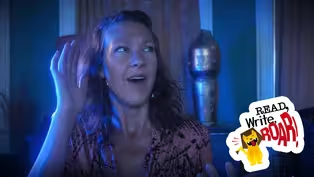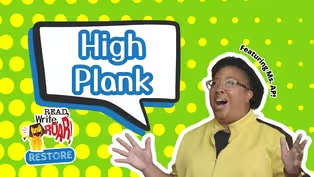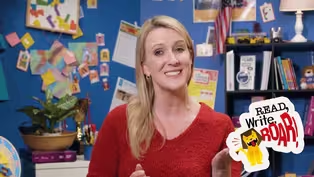Read, Write, ROAR!
How to Add Sound to Your Story
Clip: Season 1 Episode 1013 | 4m 32sVideo has Closed Captions
Explore how background sounds enhance the storytelling experience.
Explore how background sounds enhance the storytelling experience by creating mood and realism in this fun lesson on sound design for film.
Problems playing video? | Closed Captioning Feedback
Problems playing video? | Closed Captioning Feedback
Read, Write, ROAR! is a local public television program presented by Detroit PBS
Read, Write, ROAR!
How to Add Sound to Your Story
Clip: Season 1 Episode 1013 | 4m 32sVideo has Closed Captions
Explore how background sounds enhance the storytelling experience by creating mood and realism in this fun lesson on sound design for film.
Problems playing video? | Closed Captioning Feedback
How to Watch Read, Write, ROAR!
Read, Write, ROAR! is available to stream on pbs.org and the free PBS App, available on iPhone, Apple TV, Android TV, Android smartphones, Amazon Fire TV, Amazon Fire Tablet, Roku, Samsung Smart TV, and Vizio.
Providing Support for PBS.org
Learn Moreabout PBS online sponsorship[Music] I'm writing a film scene about pollinator Gardens and I want to include background sound because even if there aren't people talking in the garden it is full of sound sometimes media makers call background sound natural sound or Gat sound but they might also use terms like Ambient sound or Ambience as well we are going to use the phrase natat sound today these words mean sounds which you would expect to hear at that location like background noise or sounds made by weather Nat sound is included to help the viewer feel like they are experiencing the scene with the characters in a fictional film or the participant in a documentary film here are a few examples of natat sound if it was a sunny day and you were at a swimming pool you would expect to hear sounds of children laughing and splashing water now let's listen to the Garden do you hear the sounds of the bee moving around the flower let's find Miss Cara she's watching a film about the March on Washington while also learning about Nat sound in documentary film making hello Scholars it's so good to see see you I've been viewing the documentary film Detroit's walk to freedom to the March on Washington 60 years of civil rights Legacy this film was produced by one Detroit for Detroit PBS while I have been viewing I've also been listening to all of the extra sounds that were part of the March and which the media maker chose to include in the documentary film you see when a media maker is editing a film they can include the Gat or backround sound from the scene they recorded or they can leave it out choosing to leave in or take out the background sound can change the mood which is the tone or feeling of the film can you imagine watching a film about a Lake Michigan Beach and not hearing the waves when they hit the shore this is what the film scene looks like without the sound of waves and this is the same scene with the sound of the waves in included wow when the sound is added in I can really feel the impact of the powerful waves the 60th anniversary Walk For Freedom in Detroit was an event which was peaceful as well as one that called for continued activism in support of the civil rights movement in order to help the viewer experience this mood of Pride and unity the media maker added sounds from a marching band we heard the marching band and saw various orent organizations marching together we also heard call and response chants what do we want when do we want the sounds of the band as well as the chants helped give the viewer an idea of what the mood was like on this day it was peaceful and it was also a day the Marchers wanted Dr Martin Luther King Jr's Vision to be realized now it's your turn to think about the natural sound you would include in a scene if we were at a baseball game what kinds of sounds would we hear I'm thinking about the sound or crack of the bat hitting the ball and cheers from a crowd how about you these sounds would help create a different and exciting or energetic mood for that scene natural or not sound is important in documentary film making because it adds to the mood and makes the film feel more real for example hearing the sounds of birds chirping in a nature documentary can make viewers feel like they are actually in the forest these sounds help to create a more exciting experience making the story more believable for the viewer thank you for joining us if you want more fun ways to practice literacy skills don't forget to subscribe to the Michigan Learning Channel and be sure to check the description below for links to activity guides resources and more [Music] [Applause]
Video has Closed Captions
Clip: S1 Ep1013 | 2m 30s | Create the sounds of spaceships, mission control, and your own heartbeat in the silence of space. (2m 30s)
Found Poem: Crafting Poetry from Existing Texts
Video has Closed Captions
Clip: S1 Ep1013 | 5m 41s | Use rhythm, repetition, and rhyme, and rearrange the found words to create your own powerful poem. (5m 41s)
Pollutant & Susceptible: Decoding Multisyllabic Words
Video has Closed Captions
Clip: S1 Ep1013 | 4m 37s | Explore the secrets of words like "pollutant" and "susceptible" with Mrs. Mora. (4m 37s)
Read, Write, ROAR! Restore - High Plank
Video has Closed Captions
Clip: S1 Ep1013 | 3m 14s | Build strength with Ms. AP as she leads you through the high plank hold in this 2-minute movement s (3m 14s)
Writing to Advocate for Clean Air
Video has Closed Captions
Clip: S1 Ep1013 | 6m 22s | Learn how to advocate for clean air by writing formal letters to Michigan’s Air Quality Division. (6m 22s)
Providing Support for PBS.org
Learn Moreabout PBS online sponsorship

- Home and How To

Hit the road in a classic car for a tour through Great Britain with two antiques experts.












Support for PBS provided by:
Read, Write, ROAR! is a local public television program presented by Detroit PBS





